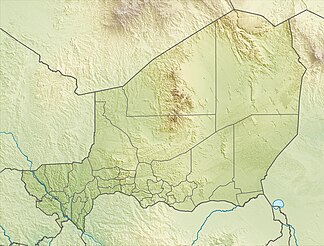Djado plateau
| Djado plateau | ||
|---|---|---|
|
View from the highest point of the Djado plateau |
||
| location | Agadez region , Niger | |
|
|
||
| Coordinates | 22 ° 13 ' N , 12 ° 27' E | |
| surface | 60,000 km² | |
The Djado Plateau is a mountain plateau located in the extreme northeast of the African state of Niger . The plateau covers an area of about 60,000 km² and reaches heights between 400 and 1,000 meters above sea level. It is surrounded by the mountain ranges of the Tibesti in the east, the Tassili n'Ajjer and Ahaggar in the northwest, the Manguéni plateau in the north and the Tchigaï plateau in the east, the large sandy deserts Ténéré in the southwest and Grand Erg Du Bilma in the south and forms one of the northern borders of the Chad Basin .
Geologically, the Djado plateau consists largely of carbonate-free sand and basalt stones , the formation of which can be traced back to the Cambrian and Mesozoic geological ages . The plateau, built up in numerous layers, is strongly karstified and is traversed by the Enneris Blaka , Achelouma, Domo, Yentas, Lobozédé, Tardijé and Odri Kolo Kaya, which have cut deep into the rock of the plateau. In the east of the plateau there are numerous smooth basaltic yardang formations that are surrounded by tall barchans . Aeolian erosion processes dominate the wind-exposed roof areas of the plateau under today's climatic conditions . Due to the north-east trade winds that predominate in the region , known locally as Harmattan , fine-grained loose material is transported from the roof areas to the foothills of the plateau and deposited there, so that the large sandy deserts could arise.
The climate in the region of the plateau is hyperarid with rainfall of around 20 to 50 mm per year. Average daytime temperatures in the region range from 25 ° C in December to 35 ° C in midsummer, with midday peaks of over 50 ° C. The vegetation is limited to areas with near-surface groundwater-bearing rock formations, which allow a sparse flora in the Enneris, and to the oases grouped around the plateau , otherwise the plateau is free of vegetation.
The region around the plateau has a long history of settlement, it can be traced back to the African Middle Stone Age . Numerous artefacts , petroglyphs and rock drawings were found in the Enneris of the plateau , the age of which could be dated to a period of 100,000 to 2,000 years. Today's settlements are limited to the oases of Chirfa , Djaba, Orida, Séguédine and Yaba, which were combined in the administrative structure of the rural municipality of Djado . Ten kilometers northeast of Chirfa are the ruins of the Plateau et Fortin du Djado , which has been on Niger's list of proposals for inclusion in the UNESCO World Heritage List since 2006 . The population in the oases consists largely of members of the Tubu people .
Individual evidence
- ↑ Karl Heinz Striedter, Robert Vernet, Nadjib Ferhat: Quaternary depressions on the southern edge of the Monts Totomaye, Djado plateau, northeast Niger: paleo-environment and prehistory. In: Paideuma. Communications on cultural studies. Frobenius Institute, Volume 38, 1992, pp. 109-141.
- ↑ The Djardo Plateau on Saharaweb ( Memento of the original from April 5, 2012 in the Internet Archive ) Info: The archive link was inserted automatically and has not yet been checked. Please check the original and archive link according to the instructions and then remove this notice. (English)
- ↑ Barbara Sponholz: Sedimentological investigations on backfilling of silicate karst forms in the Djado and at the level of Bilma. Geographical Institute UNI Würzburg. (PDF document 4.9 MB)
- ↑ Harald A. Friedl: The justifiability of ethnotourism using the example of the Tuareg of the Agadez region, Republic of Niger (West Africa) - An evaluation from the perspective of applied tourism ethics. Grin Verlag, 2005, ISBN 3-638-41721-2 .
- ↑ Entry in UNESCO's list of suggestions (French)

